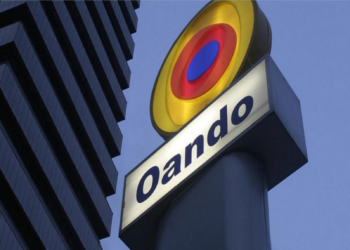Oando Plc last year delivered an impressive 159 per cent on stock performance in a year-to-date gain. The momentum has continued into 2024, albeit a modest start, as the share price increased by 14 per cent in Q1.
However, following the release of its 2023 financial results on May 31, 2024, which revealed a significant turnaround with a pre-tax profit of N104.1 billion compared to a pre-tax loss of N61.8 billion in 2022, the stock was up 9.8% intraday to N11.8 per share.
The rally intensified after Oando announced the Nigerian government’s approval of its 100% acquisition of Nigerian Agip Oil Company Limited, pushing the share price to a five-year high of N47.85 and a year-to-date gain of 371.5%; ranking it as the second-best performing stock on the NGX.
The recent price rally prompts a closer examination of the financial performance driving Oando’s growth, particularly its 2023 results. The company’s turnaround from significant losses in previous years to a pre-tax profit of N104.1 billion in 2023 represents a crucial shift.
According to the unaudited interim financial statements for the 12 months ending December 31, 2023, reviewed by Nairametrics, Oando’s recovery is largely attributed to a substantial foreign exchange gain of N378 billion, which boosted operating profit to N214.5 billion.
This gain was achieved despite a 2% year-over-year decline in gross profit, which fell to N77.039 billion and resulted in a low-profit margin of 2.26%. The decrease in profit margin can be attributed to the high cost of sales, which consumed over 97% of revenue.
Commenting on these results, Wale Tinubu, Group Chief Executive of Oando PLC, said: “Despite persistent pipeline vandalism across the Niger Delta, which continues to dampen crude production, we achieved a profit after tax of N74.7 billion in 2023. This was largely driven by increased trading volumes from our strategic global partnerships and net foreign exchange gains on the group’s foreign currency-denominated assets, contrasting with losses on our foreign currency-denominated liabilities.”
Revenue grew by 71% YoY to N3.4 trillion, yet the cost of sales increased by 74% YoY to N3.3 trillion. Supply and trading activities dominated the revenue mix, contributing 77% of total revenue, while exploration and production accounted for only four per cent. Despite this, exploration and production had a significant impact on profitability, contributing 53% to operating profit and 41% to pre-tax profit, highlighting the potential for improved profitability through a greater focus on these activities. The recent acquisition of Nigerian Agip Oil Company could be transformative for Oando, potentially boosting its production capacity and shifting its revenue mix towards more stable and profitable sources.
Group Chief Executive of Oando PLC, Wale Tinubu, emphasized the company’s focus on optimizing these new assets, advancing production, and pursuing strategic diversification in areas such as clean energy and energy infrastructure. By doubling its interests in OMLs 60, 61, 62, and 63 from 20% to 40%, Oando is poised to significantly enhance its production and revenue, contributing to top-line growth and overall profitability.
One of the most promising aspects of the acquisition is that it is described as “immediately cash generative.” This suggests that it is expected to quickly begin contributing to Oando’s cash flows, which were already impressive last year, with cash flow from operating activities standing at N155 billion.
This strong cash flow is crucial for supporting ongoing operations, funding future projects, and servicing debt. Moreover, robust cash flow generation can improve liquidity and potentially lead the company to pay dividends again. The acquisition also may enhance Oando’s ability to manage costs effectively, as owning and operating the acquired assets allows for more strategic cost management, potentially improving profitability.
However, the high cost of sales remains a critical issue. For instance, the 2023 financial performance showed that cost of sales consumed 97% of revenue, leaving little room for profit.
To ensure sustainable growth and profitability, Oando must improve operational efficiency and reduce costs. The additional production capacity from the acquisition could play a vital role, but effective execution of this strategy is essential.
Despite Oando’s recent return to profitability and the acquisition, investors must consider the company’s financial history and current valuation metrics.
One significant point is that Oando has not paid dividends for at least the past five years, which may deter income-focused investors. This long dividend drought may be linked to retained losses totaling N488 billion as of December 2023.
Valuation metrics suggest that Oando’s stock is undervalued compared to industry averages. The price-to-earnings (P/E) ratio is 7.44x, significantly lower than the industry average of 45.97x, indicating potential undervaluation. This could be attractive to value investors looking for stocks priced below their intrinsic value.
The price-to-free cash flow ratio at 5.14 is lower than the industry average of 8.27, suggesting potential undervaluation relative to the free cash flow generated. Yet, this is tempered by ongoing challenges, including high debt levels and a need for operational improvements.
However, the price-to-cash flow ratio is higher at 3.49, compared to the industry average of 0.35, signaling possible inefficiencies in converting sales into cash, a mixed signal for cash flow-focused investors.
Lastly, the price-to-book (P/B) ratio is negative at -2.53, compared to the industry average of 0.47, reflecting significant financial distress due to substantial negative shareholders’ funds.
For investors, the key takeaway is that while Oando’s stock might appear undervalued based on certain metrics like P/E and P/FCF, the company’s financial health remains fragile. The lack of dividends, significant retained losses, negative shareholders’ funds, and high debt levels are major concerns. While the recent profitability and strategic acquisitions could indicate a turning point, investors need to be cautious.
The stock may offer potential upside for those with a high-risk tolerance who believe in the company’s turnaround strategy, but it also comes with significant risks, particularly if the company fails to sustain its recent improvements.


